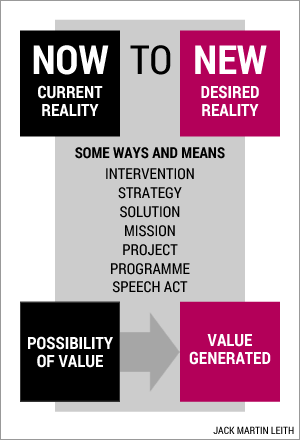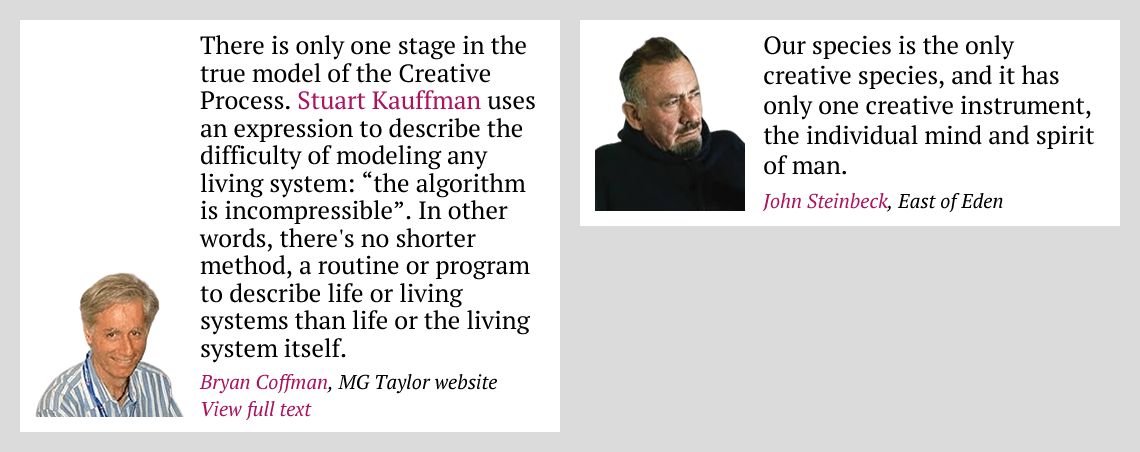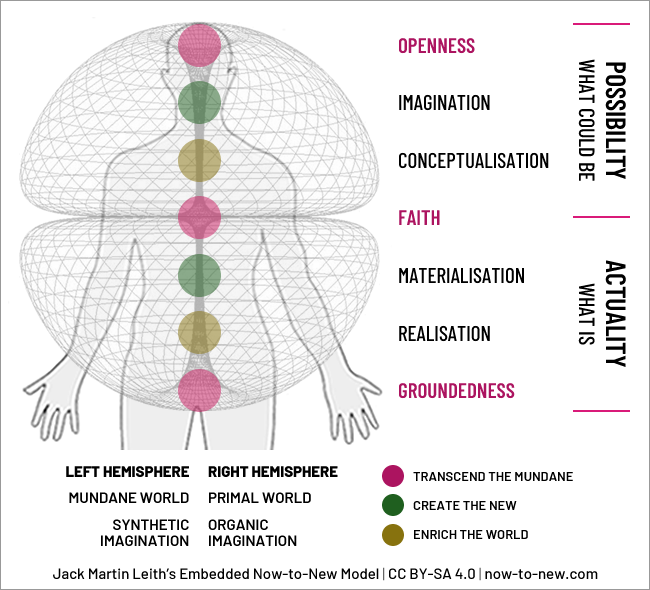Welcome to the Now-to-New website, where I share my discoveries about transcending the mundane, imagining what could be, bringing it into being and enriching the world with value, meaning and joy.
The site is a non-commercial venture. You are free to reuse material I have created as specified in the Creative Commons Attribution-ShareAlike 4.0 International license. Note that this does not extend to the many text excerpts and images drawn from external sources.How it began
Now-to-New is a term I came up with in the 1990s when working as an independent consultant specialising in breakthrough innovation, system-wide change and multi-stakeholder co-creation, and while conducting an extended inquiry into how the new comes into being, and how this changes into that, beyond prevailing models and methods.
At first, Now-to-New was simply a blanket term covering innovation, change and problem solving work.

I coined this term because no matter how the project is framed by the people involved, the purpose of any innovation, change or problem solving project is creating a shift from the way things are right NOW to a NEW reality, a new Now, in which the desired results have been accomplished. The new product or service has been launched, the change has happened or the problematic situation is a thing of the past.
Imagine that three people meet to discuss a joint project. Person A frames it as an innovation project. Person B thinks it’s a problem solving project. Person C considers it a change project. Consequently there’s no shared language, no common mental model and no collective understanding, resulting in crossed wires and the design and deployment of a suboptimal intervention.
Now-to-New fosters unity of purpose and focused collaborative action by providing clear distinctions and straightforward conceptual frameworks that everyone agrees to adopt.
What followed
Later, I wrote about the various models, methods and processes that can be deployed by a Now-to-New practitioner, such as Osborn Parnes Creative Problem-Solving Process, design thinking, MG Taylor DesignShop, Theory U, and large group intervention methods (pdf) such as Open Space Technology, Future Search and Real Time Strategic Change — prominent in my professional work for many years.
Read about some open source and proprietary Now-to-New methods
During the period starting in the early 1990s and continuing right up to the present, I devised the series of Now-to-New project models displayed below in thumbnail form:

You can read about the four versions here. The current one is explained below.
Currently
My own Now-to-New work, at present directed towards creating and developing this website, is guided by the Now-to-New prospectus.

But no matter who carries out Now-to-New work, attention is always focused on the end result — the outcome and eventual value to be generated — rather than the process, the means by which the project’s ends will be accomplished.
In the business and organisational world there’s an obsession with process.
But even the most sophisticated process cannot imagine groundbreaking possibilities, cannot elaborate potent ideas into fully formed concepts, and cannot do the hard graft of bringing concepts to life, propelled by a heartfelt desire to enrich the world with value, meaning and joy.
Only human beings can do these things, and they have been doing so, successfully, since long before innovation and change processes were invented.
 Human beings are built for converting Now into New using mind, spirit, and a third aspect that John Steinbeck doesn’t mention here: body.
Human beings are built for converting Now into New using mind, spirit, and a third aspect that John Steinbeck doesn’t mention here: body.
I’ve spent many decades working towards the embodied mind-body-spirit model pictured below.

Dual torus image sourced from Michael C Grasso and decoloured.
Mind is represented by the horizontal plane.My understanding of the brain’s left and right hemisphere differences is informed by the work of Iain McGilchrist and a few other people.
Body is represented by the vertical plane.
I consulted multiple sources, engaged in much deliberation and produced many iterations before settling on this depiction.
Each of the seven constituents is associated with a specific location in the body.
Together, Openness, Faith and Groundedness represent a state of being in which the creative faculties of Imagination, Conceptualisation, Materialisation and Realisation (of potential) are fully activated and ready to be deployed.
Spirit is represented by the heart, the seat of Faith, situated at the intersection of the two planes.
I am not using Faith in the religious sense but rather with the meaning conveyed in the passages below.
Faith is a critical but curious mind’s readiness to adopt a reality model (even if provisionally) for which there is less than absolute, empirical proof.
Jay B. Gaskill, The Dialogic Imperative
The heart is where we experience intent, an unceasing desire to serve others and enrich the world.Faith is an existential commitment of the heart, a way of life, a set of behaviors and emotional responses woven into every hour of everyday life — expressed through constant choices both when alone and in social situations.
Peter A. Georgescu, Faith isn’t irrational, but beliefs may be, on Huffington Post | Peter A. Georgescu is Chairman Emeritus of advertising agency network Young & Rubicam, Inc.
Read more about the embodied Now-to-New model
I wish you value, meaning and joy as you continue your Now-to-New explorations.
Jack
Jack Martin Leith
Bristol, United Kingdom
February 2025
Continue reading
Now-to-New
The evolution of the Now-to-New project model
How the term Now-to-New came into being
Readiness work sets the Now-to-New project in motion
The seven kinds of Now-to-New work
Some open source and proprietary Now-to-New methods
The three Now-to-New action modes — Part 1
The three Now-to-New action modes — Part 2
Related topics
The two forms of imagination: synthetic and organic
General
Search the site
Not case sensitive. Do not to hit return.